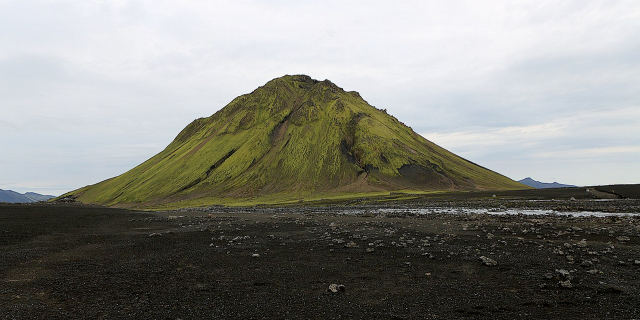Kirkjugólf (Church Land in Icelandic) is a natural monument consisting of a natural path of basaltic columns buried and eroded by glaciers in such a way that only the heads can be seen and, as the name suggests, they look like the tiled floor of a church. The complex is located about 400 meters northeast of Kirkjubæjarklaustur in the Suðurland region.
It has an extension of approximately 80 m² of basalt columns, which glaciers and waves have eroded and shaped. There has never been a church but the floor suggests that it is man-made. Basalt columns form when the lava flow cools and contractional forces cause it to accumulate. The cracks form horizontally and the network of fractures extends, forming six-sided columns. Kirkjugólf is a protected natural monument. Although columns are generally hexagonal, there are variations. Basalt columns have traditionally been a source of inspiration for Icelanders, and many of them have used their form in works of art.
...Read more
Kirkjugólf (Church Land in Icelandic) is a natural monument consisting of a natural path of basaltic columns buried and eroded by glaciers in such a way that only the heads can be seen and, as the name suggests, they look like the tiled floor of a church. The complex is located about 400 meters northeast of Kirkjubæjarklaustur in the Suðurland region.
It has an extension of approximately 80 m² of basalt columns, which glaciers and waves have eroded and shaped. There has never been a church but the floor suggests that it is man-made. Basalt columns form when the lava flow cools and contractional forces cause it to accumulate. The cracks form horizontally and the network of fractures extends, forming six-sided columns. Kirkjugólf is a protected natural monument. Although columns are generally hexagonal, there are variations. Basalt columns have traditionally been a source of inspiration for Icelanders, and many of them have used their form in works of art.
The name Kirkjugólf suggests that there was, at some point, a church there, and many associate it with tales of Irish hermits and their stay in the area before the establishment of Iceland. However, there is no record that there was ever a church or any other structure. The texture and appearance of the rock has become smooth and regular over the years without human intervention. Kirkjugólf is the base archetype on which the island guardians (called landvættir in Icelandic) stand on the shield of Iceland.


























Add new comment